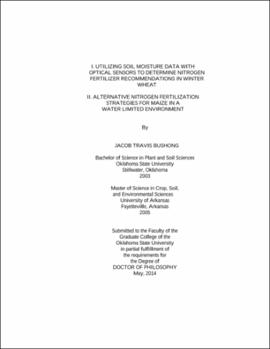I. Utilizing soil moisture data with optical sensors to determine nitrogen fertilizer recommendations in winter wheat
II. Alternative nitrogen fertilization strategies for maize in a water limited environment
| dc.contributor.advisor | Raun, William | |
| dc.contributor.author | Bushong, Jacob Travis | |
| dc.date.accessioned | 2015-06-17T20:05:04Z | |
| dc.date.available | 2015-06-17T20:05:04Z | |
| dc.date.issued | 2014-05 | |
| dc.identifier.uri | https://hdl.handle.net/11244/14747 | |
| dc.description.abstract | The impact soil moisture can have on nitrogen (N) fertilizer management can be substantial. A series of trials were conducted to evaluate the effect of soil moisture on N management practices in winter wheat and maize. The first series of trials focused on improvements of in-season N fertilizer recommendation in winter wheat. In winter wheat, optical sensors coupled with mathematical algorithms have been used to improve midseason N fertilizer rate recommendations. One of the key components to these algorithms is the in-season estimate of grain yield. To improve upon current algorithms, soil moisture parameters were incorporated into the yield prediction models. Slight improvements were observed in the ability to predict grain yield by utilizing soil moisture data at the time of sensing. However, no significant differences were observed in the ability of the new yield prediction to determine the agronomic optimum N rate compared to current N fertilizer recommendation algorithms. The other set of trials evaluated the effects of different N fertilizer management practices on grain yield, N use efficiency (NUE), and water use efficiency (WUE) for maize grown in a rain-fed or deficit irrigation environment. Deficit irrigation improved grain yield, WUE, and NUE compared to rain-fed treatments. Split N fertilizer applications typically increased the NUE, but not always the grain yield. Mid-season foliar N applications did have the potential to improve grain yield and NUE, however if significant leaf burn was observed, grain yields were reduced. The preplant application of a pure ammoniacal source of N fertilizer, such as ammonium sulfate (AS), had a tendency to increase grain yields and NUE for rain-fed treatments. The use of urea ammonium nitrate (UAN) as a preplant N fertilizer source performed just as well or better at improving grain yield compared to AS, as long as potential N loss mechanisms were minimized. In conclusion, knowledge of soil moisture and its effects on N fertilizer management can help improve the efficiency of N and sustainability of other resources for cereal grain production. | |
| dc.format | application/pdf | |
| dc.language | en_US | |
| dc.rights | Copyright is held by the author who has granted the Oklahoma State University Library the non-exclusive right to share this material in its institutional repository. Contact Digital Library Services at lib-dls@okstate.edu or 405-744-9161 for the permission policy on the use, reproduction or distribution of this material. | |
| dc.title | I. Utilizing soil moisture data with optical sensors to determine nitrogen fertilizer recommendations in winter wheat | |
| dc.title | II. Alternative nitrogen fertilization strategies for maize in a water limited environment | |
| dc.contributor.committeeMember | Arnall, Daryl Brian | |
| dc.contributor.committeeMember | Klatt, A. R. | |
| dc.contributor.committeeMember | Taylor, Randal K. | |
| osu.filename | Bushong_okstate_0664D_13237.pdf | |
| osu.accesstype | Open Access | |
| dc.type.genre | Dissertation | |
| dc.type.material | Text | |
| thesis.degree.discipline | Soil Science | |
| thesis.degree.grantor | Oklahoma State University |
Files in this item
This item appears in the following Collection(s)
-
OSU Dissertations [11222]
